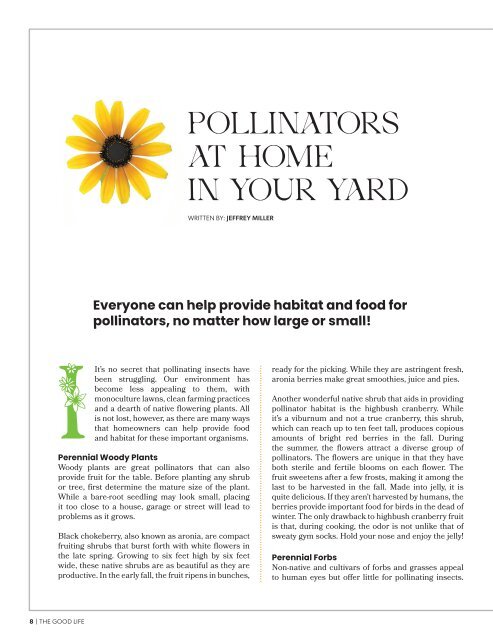The Good Life – July-August 2023
Ten years, hundreds of stories, and thousands of lives impacted. Founders of The Good Life reveal the magazine's origin story (and more) to mark its 10th anniversary. Also in this issue, Dad Life on the topic of Helicopter Parents, the Cass County Sheriff’s Office and its fleet of vehicles, Having A Beer with Dawn and Darren from Urban Toad Media and more!
Ten years, hundreds of stories, and thousands of lives impacted. Founders of The Good Life reveal the magazine's origin story (and more) to mark its 10th anniversary.
Also in this issue, Dad Life on the topic of Helicopter Parents, the Cass County Sheriff’s Office and its fleet of vehicles, Having A Beer with Dawn and Darren from Urban Toad Media and more!
You also want an ePaper? Increase the reach of your titles
YUMPU automatically turns print PDFs into web optimized ePapers that Google loves.
POLLINATORS<br />
AT HOME<br />
IN YOUR YARD<br />
WRITTEN BY: JEFFREY MILLER<br />
Everyone can help provide habitat and food for<br />
pollinators, no matter how large or small!<br />
IIt’s no secret that pollinating insects have<br />
been struggling. Our environment has<br />
become less appealing to them, with<br />
monoculture lawns, clean farming practices<br />
and a dearth of native flowering plants. All<br />
is not lost, however, as there are many ways<br />
that homeowners can help provide food<br />
and habitat for these important organisms.<br />
Perennial Woody Plants<br />
Woody plants are great pollinators that can also<br />
provide fruit for the table. Before planting any shrub<br />
or tree, first determine the mature size of the plant.<br />
While a bare-root seedling may look small, placing<br />
it too close to a house, garage or street will lead to<br />
problems as it grows.<br />
Black chokeberry, also known as aronia, are compact<br />
fruiting shrubs that burst forth with white flowers in<br />
the late spring. Growing to six feet high by six feet<br />
wide, these native shrubs are as beautiful as they are<br />
productive. In the early fall, the fruit ripens in bunches,<br />
ready for the picking. While they are astringent fresh,<br />
aronia berries make great smoothies, juice and pies.<br />
Another wonderful native shrub that aids in providing<br />
pollinator habitat is the highbush cranberry. While<br />
it’s a viburnum and not a true cranberry, this shrub,<br />
which can reach up to ten feet tall, produces copious<br />
amounts of bright red berries in the fall. During<br />
the summer, the flowers attract a diverse group of<br />
pollinators. <strong>The</strong> flowers are unique in that they have<br />
both sterile and fertile blooms on each flower. <strong>The</strong><br />
fruit sweetens after a few frosts, making it among the<br />
last to be harvested in the fall. Made into jelly, it is<br />
quite delicious. If they aren’t harvested by humans, the<br />
berries provide important food for birds in the dead of<br />
winter. <strong>The</strong> only drawback to highbush cranberry fruit<br />
is that, during cooking, the odor is not unlike that of<br />
sweaty gym socks. Hold your nose and enjoy the jelly!<br />
Perennial Forbs<br />
Non-native and cultivars of forbs and grasses appeal<br />
to human eyes but offer little for pollinating insects.<br />
8 | THE GOOD LIFE

















